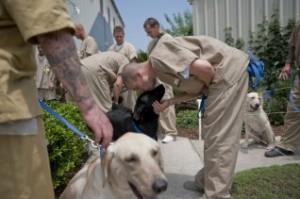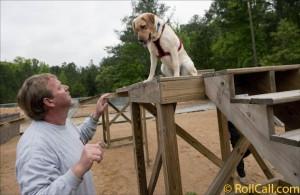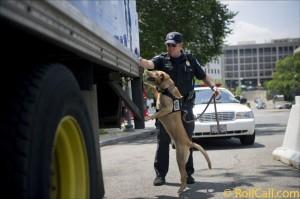 Barney knew he would be on a short leash after leaving the Bay Correctional Facility in Panama City, Fla.
Barney knew he would be on a short leash after leaving the Bay Correctional Facility in Panama City, Fla.
He would spend the next several months in Alabama in physical training, running 10 miles a day and learning to detect subtle, yet deadly, explosive threats.
Then he would head north, to help protect the U.S. Capitol.
Barney is a springer spaniel.
It’s a job for the dogs: keeping Capitol Hill safe from the threat of explosives.
But not for just any dogs. The journey for the Capitol Police’s canine bomb detectors starts in Anniston, Ala., at Auburn University’s Canine Detection Training Center, where pups are trained to do the dangerous and vigorous job.
Sporting breeds, such as retrievers, are the main choice for bomb detectors. The reason is simple. Because bomb detection dogs must work in close proximity to large groups of people, sporting breeds are valued because they are generally less intimidating than other police dogs, such as German shepherds, rottweilers or Doberman pinschers.
Behind Bars

The relationships the dogs develop with the inmates is a key part of their training, as they learn to bond with people before learning to protect them. The inmates say they benefit from the program as much as the dogs.
It’s akin to a full-time job for the men, who must care for, exercise and feed the dogs, giving them a sense of responsibility for living creatures, “as if they were our kids,” as many inmates noted.
William Snelgrove said one of the best parts of the program was “that I’m giving back to the community,” adding, “I’ve seen the hardest criminal show a softer side taking care of these dogs. It changes them.”
Douglas Whitney said, “It’s taught me to respect life. I’m more patient and caring now than when I came here.”
In addition to basic discipline and socialization, the dogs also begin basic scent training at the prison, with exercises such as finding scent rags hidden in desks.
On the Plains
Once the dogs leave Panama City, they head for a ramped-up training program at Auburn.
Auburn’s Canine Detection Training Center is a unique place, as it works in tandem with Auburn University’s Canine Detection Research Institute to breed and prepare the dogs for a life locating explosives.
A puppy enters the program shortly after birth and is exposed to various environmental aspects that focus its natural abilities over the course of its first year of life. The first three months of the pup’s life are spent there. The next nine are spent at Bay Correctional Facility. When they return to Auburn, the most exhaustive part of their training begins. In addition to scent detection training, the dogs also ramp up their conditioning, running up to 10 miles a day.
After a month or two of training upon their return to Auburn, the dogs are assigned a handler. The new teams then undergo a 10-week basic explosives handler course. Part of that training involves putting the dogs in real-world environments, such as shopping malls.
The elite dogs are eventually selected for the “Vapor Wake Detection” program. This program entails a specialized skill set developed in the wake of the 9/11 terrorist attacks. It trains dogs to detect carried or body-worn explosives through analysis of the plume of air coming off a person and what they are carrying through a crowd.
Traditional bomb detection dogs have the ability to sniff explosives close up. Vapor Wake dogs can sense the moving explosives at a much greater range and for as long as 15 minutes, and they are trained to track down the scent’s origin. Such skills are ideal for areas with heavy pedestrian traffic, such as the Capitol or Union Station, without slowing the overall traffic flow.
Jordanesque

“It’s surprising how intelligent the dogs are,” Capitol Police K9 Technician Tiffany White said. “It exceeds any expectations you may have had before.”
The Capitol Police use the dogs in a variety of ways, spending their time at posts or mobile shifts, as well as area sweeps through the campus. The unit has an expanded scope beyond campus as well, having been deployed to the political conventions last summer.
The dogs and K9 technicians train and work together so long that deep bonds develop, with police officers echoing what the inmates at Bay Correctional Facility said about the dogs. “It’s like they are a family member,” White said.
Perhaps that explains why, when it’s time for the dogs to end their careers, which can last as long as 10 years, they frequently have homes waiting for them. Capitol Police K9 Technician Shawn Hayes, for instance, adopted his previous working dog, Hawk, in 2011.
~ Courtesy of Roll Call
Tags: Capitol police dogs, dog training, elite dogs
